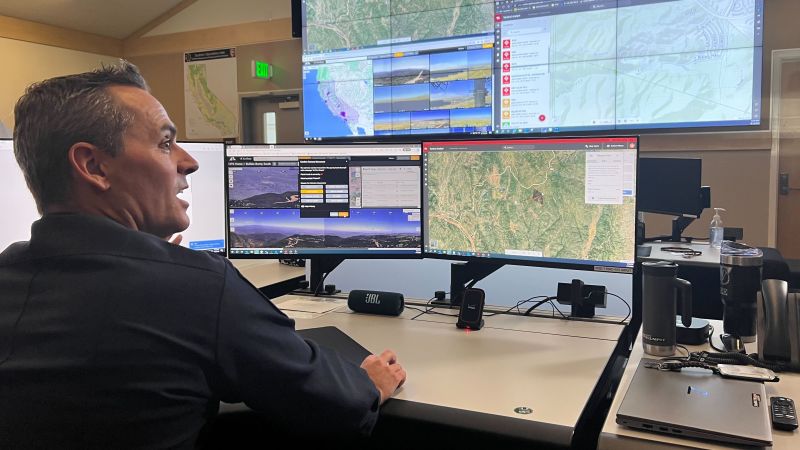### Summary
California officials are exploring different methods to prevent wildfires, including artificial intelligence and goats.
### Facts
- 🌡️ A summer heat wave in California is increasing the risk of wildfires.
- 🤖 California officials are considering using artificial intelligence to predict and prevent wildfires.
- 🐐 Goats are also being considered as a method to prevent wildfires.
(Note: The AI and goat methods are not explained in further detail in the given text.)
Artificial intelligence sensors are being implemented in Santa Clara County to analyze air temperature and particles to detect and prevent wildfires, with a focus on protecting the local water supply.
Researchers at Aalto University have developed an AI model, called FireCNN, that uses a convolutional neural network to predict effective strategies for preventing wildfires, potentially reducing up to 76% of wildfires.
California is using AI technology to fight fires faster and smarter, saving lives and communities from destruction, as demonstrated by a pilot program that has already detected and alerted CAL FIRE to 77 fires before 911 calls were made.
Insurers in Florida are using aerial imagery and artificial intelligence to manage climate change risks, reduce fraud, and accurately assess property damage, as climate disasters increase in frequency and intensity. By leveraging historical imagery data, carriers can detect fraudulent claims and make more informed underwriting decisions, contributing to more affordable premiums for customers. Technological advancements, such as AI-based predictive analytics and improved aerial imagery resolution, enable insurers to respond effectively to natural disasters and allocate resources efficiently.
Greek Prime Minister Kyriakos Mitsotakis has announced that Greece is collaborating with Israel to develop artificial intelligence technology for early detection of wildfires, following talks with Israeli Prime Minister Benjamin Netanyahu and Cypriot President Nikos Christodoulides in Nicosia. The leaders also discussed the possibility of bringing Israel into EU civil protection initiatives to improve coordination of firefighting efforts.
The Washington Department of Natural Resources is partnering with T-Mobile and Pano AI to install a network of cameras equipped with artificial intelligence to detect wildfires in remote areas, improving response time and alerting nearby communities.
Danish start-up Robotto has developed a drone that uses artificial intelligence to track and monitor wildfires in real-time, providing firefighters with up-to-date information to make informed decisions and allocate resources effectively. The technology has already been tested by Catalonia's wildfire fighting unit and is also being used for other applications such as monitoring wildlife and preventing poaching.
AI-powered tools developed by AltaML are helping duty officers in Alberta Wildfire, Canada's forest firefighting agency, make better decisions regarding the positioning of resources to combat wildfires. The tools analyze data points and use machine learning to predict the likelihood of new fires, optimizing resource allocation and saving costs. The models have been successful in accurately predicting wildfire occurrences 80% of the time. This technology aims to improve cost efficiency and ensure resources are in the right place at the right time to respond to fires.
Queen Creek Police Department in Arizona will be the first in the state to use artificial intelligence (AI) software to review police body cam footage, aiming to reduce use of force and promote de-escalation by analyzing officer interactions and creating report cards for each officer. AI technology, such as Truleo, has shown promise in lowering use-of-force incidents in other departments, although further independent studies are needed to assess the potential costs and outcomes.
Artificial intelligence technology is being used to monitor and conserve species in rainforests, offering hope for the survival of declining species impacted by global warming, deforestation, and development. The AI platform Arbimom analyzes audio recordings collected from rainforests, allowing for faster and more efficient analysis of species behavior, habitat changes, and threats.
Artificial intelligence-enabled cameras, such as the TrailGuard system, are being used to help conservationists protect tigers and other wildlife by distinguishing between species and transmitting images to park rangers or villagers within seconds, leading to a decrease in false alarms and increased efficiency in wildlife surveillance.
Austin City Council has approved a contract between an artificial intelligence company, Pano AI, and Austin Energy to use high-definition cameras and AI technology to detect wildfire smoke and expedite fire response in Texas.
Scientists and natural resource managers have developed a groundbreaking technology called "Salmon Vision," which combines artificial intelligence with fishing weir technology to accurately identify and count salmon species in real-time, aiding fisheries managers in making informed decisions.
